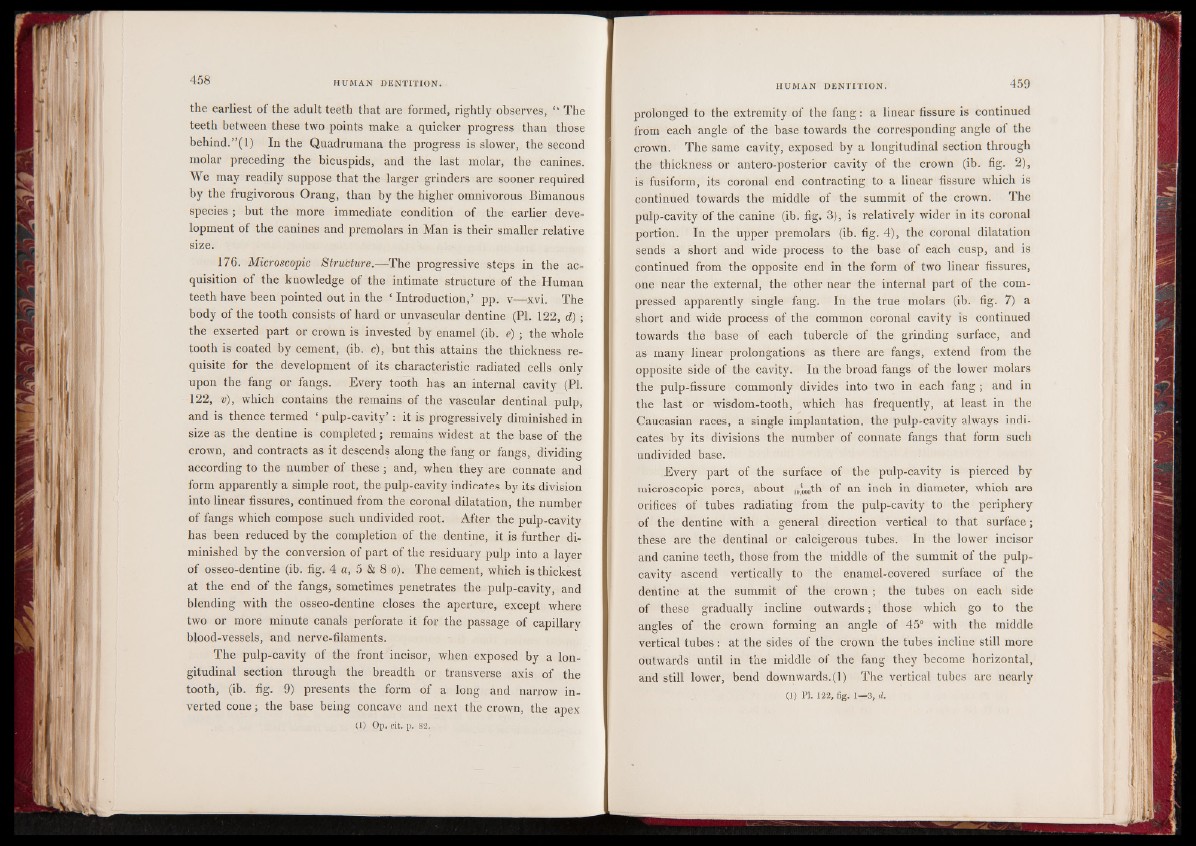
the earliest of the adult teeth that are formed, rightly observes, “ The
teeth between these two points make a quicker progress than those
behind.”(1) In the Quadrumana the progress is slower, the second
molar preceding the bicuspids, and the last molar, the canines.
We may readily suppose that the larger grinders are sooner required
by the frugivorous Orang, than by the higher omnivorous Bimanous
species ; but the more immediate condition of the earlier development
of the canines and premolars in Man is their smaller relative
size.
176. Microscopic Structure.—The progressive steps in the acquisition
of the knowledge of the intimate structure of the Human
teeth have been pointed out in the ‘ Introduction,’ pp. v—xvi. The
body of the tooth consists of hard or unvascular dentine (PI. 122, d) ;
the exserted part or crown is invested by enamel (ib. e) ; the whole
tooth is coated by cement, (ib. c), but this attains the thickness requisite
for the development of its characteristic radiated cells only
upon the fang or fangs. Every tooth has an internal cavity (PI.
122, v), which contains the remains of the vascular dentinal pulp,
and is thence termed ‘ pulp-cavity’ : it is progressively diminished in
size as the dentine is completed; remains widest at the base of the
crown, and contracts as it descends along the fang or fangs, dividing
according to the number of these ; and, when they are connate and
form apparently a simple root, the pulp-cavity indicates by its division
into linear fissures, continued from the coronal dilatation, the number
of fangs which compose such undivided root. After the pulp-cavity
has been reduced by the completion of the dentine, it is further diminished
by the conversion of part of the residuary pulp into a layer
of osseo-dentine (ib. fig. 4 a, 5 & 8 o). The cement, which is thickest
at the end of the fangs, sometimes penetrates the pulp-cavity, and
blending with the osseo-dentine closes the aperture, except where
two or more minute canals perforate it for the passage of capillary
blood-vessels, and nerve-filaments.
The pulp-cavity of the front incisor, when exposed by a longitudinal
section through the breadth or transverse axis of the
tooth, (ib. fig. 9) presents the form of a long and narrow inverted
cone; the base being concave and next the crown, the apex
(1) Op. cit. p, 82,
prolonged to the extremity of the fang: a linear fissure is continued
from each angle of the base towards the corresponding angle of the
crown. The same cavity, exposed by a longitudinal section through
the thickness or antero-posterior cavity of the crown (ib. fig. 2),
is fusiform, its coronal end contracting to a linear fissure which is
continued towards the middle of the summit of the crown. The
pulp-cavity of the canine (ib. fig. 3), is relatively wider in its coronal
portion. In the upper premolars (ib. fig. 4), the coronal dilatation
sends a short and wide process to the base of each cusp, and is
continued from the opposite end in the form of two linear fissures,
one near the external, the other near the internal part of the compressed
apparently single fang. In the true molars (ib. fig. 7) a
short and wide process of the common coronal cavity is continued
towards the base of each tubercle of the grinding surface, and
as many linear prolongations as there are fangs, extend from the
opposite side of the cavity. In the broad fangs of the lower molars
the pulp-fissure commonly divides into two in each fang ; and in
the last or wisdom-tooth, which has frequently, at least in the
Caucasian races, a single implantation, the pulp-cavity always indicates
by its divisions the number of connate fangs that form such
undivided base.
Every part of the surface of the pulp-cavity is pierced by
microscopic pores, about j^ th of an inch in diameter, which are
orifices of tubes radiating from the pulp-cavity to the periphery
of the dentine with a general direction vertical to that surface;
these are the dentinal or calcigerous tubes. In the lower incisor
and canine teeth, those from the middle of the summit of the pulp-
cavity ascend vertically to the enamel-covered surface of the
dentine at the summit of the crown; the tubes on each side
of these gradually incline outwards; those which go to the
angles of the crown forming an angle of 45° with the middle
vertical tubes: at the sides of the crown the tubes incline still more
outwards until in the middle of the fang they become horizontal,
and still lower, bend downwards,(1) The vertical tubes are nearly
(0 PI. 122, fig. 1—3, d.